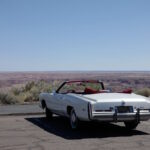Has it really been 60 years since the world fell in love with Chevrolet’s Corvette? Fans of “America’s Sports Car” will have a chance to rekindle that romance with a dynamic Corvette 60th anniversary display at the Sept. 19-22 AutoFair at Charlotte Motor Speedway that every die-hard Chevrolet enthusiast and sports car fan will appreciate.
The fall AutoFair features more than 50 car club displays and more than 7,000 vendor spaces that offer a plethora of automotive parts and memorabilia. More than 1,500 collectible vehicles of all makes and models will be available for sale in the car corral that rings the 1.5-mile superspeedway. In addition, up to 200 cars will be auctioned by Dealer Auctions Inc., and kids can enjoy face-painting, bounce houses and other games and entertainment in the huge Play Zone.
The Corvette was born in 1953 with a limited run of 300 Polo White units built by hand from lightweight, experimental fiberglass panels. Following the European pattern for sports car design, that first generation (produced from 1953 through 1962 and now referred to as the “C1” or “Corvette generation 1” by enthusiasts) came only as a roadster with precious few creature comforts. It was powered by a sturdy but sluggish six-cylinder engine until 1955, when it received Chevrolet’s much-anticipated small-block 265ci V-8. The rest of the world has been playing catch-up to the Corvette ever since.
The car we now call the C2 Corvette appeared in 1963, although its official model name was borrowed from GM styling director Bill Mitchell’s personal race car, the Stingray. All Corvettes made from 1963 through 1967 wore a “Sting Ray” badge and, in profile, resembled a shark in attack mode. They also were available in either coupe or convertible and featured a grocery list of performance and comfort equipment to appeal to Chevy’s more traditional buyers. Mechanical improvements marking the C2 included concealed headlights for better airflow at high speeds, independent rear suspension, and a more powerful lineup of V-8 engines ranging from 327ci to 427ci.
The C3 ran from 1968 through 1982 as a coupe and through 1975 as a convertible, but with an interesting third option—the T-top coupe with removable roof panels—that offered buyers an enticing compromise. This generation’s styling was lower and pointier than ever and featured the marque’s first pop-up headlights. Oddly, the 1968 Corvette was not marketed as a Sting Ray, but the name would return from 1969 through 1976 as one word, Stingray. Engines grew larger again, ranging from 350ci to an astounding 454ci V-8 that cranked out 450 horsepower, but not for long. The American auto industry had to meet strict federal standards for emissions and safety, which had the effect of watering down the Corvette’s performance for nearly a decade.
When the C4 debuted in 1984, it was praised for its fresh, minimalist styling, track-ready suspension, and powerful modern 350ci V-8. Gone was the ’70s-era T-top; in its place was a solid one-piece Targa roof panel that could be stowed in the Corvette’s roomy luggage area. A true convertible C4 would resume in 1986. With its “4+3-speed” manual transmission, run-flat tires and anti-lock brake systems introduced during its 1984-96 run, the C4 was the first truly computer-designed and managed Corvette.
The C5, which ran from 1997 to 2004, had two items Corvette engineers had been dreaming about since the 1950s: an aluminum V-8 engine and a transmission relocated to the back of the car for ideal weight distribution. At 179.7 inches of overall length and a wheelbase of 104.5 inches, the C5 was also the largest model to wear the Corvette’s crossed-flags badge. The body was as smooth as a wet bar of soap, which contributed to a top speed of 181 miles per hour and amazing 28 miles per gallon of gas.
Corvette engineers produced another world-class supercar with the 2005-13 C6, which carried a 364ci V-8 that produced 400 horsepower and could reach 60 miles per hour in 4.2 seconds on its way to a top speed of 190 miles per hour—all while returning 26 miles per gallon on the highway. Designers took away the Corvette’s traditional hidden headlights, replacing them with high-intensity fixed units that give the C6 front a predatory stare-down appearance. Chevrolet built the final C6 in February of this year in order to prep its Bowling Green, Ky., plant for production of the fastest standard Corvette in history.
The new-for-2014 C7 Corvette Stingray is a technological marvel on par with any European supercar but for a fraction of the sticker price. It also marks the first Corvette generation not available or serviceable through all Chevrolet dealerships. By visiting one of the specially trained and equipped C7 Corvette dealers, an enthusiast can drive away in a two-seat dream machine powered by a 455-horsepower, 376ci V-8 that shifts through a seven-speed manual transmission for $51,000. That drivetrain is cradled in an aluminum chassis and covered by a carbon-fiber roof and hood, all of which have been sculpted into the most aggressive envelope since billionaire Bruce Wayne combined a Stealth fighter with an urban assault vehicle. Zero-to-60 times are in the sub-4.0-second range, and top speed is expected to nudge 200. Even with acceleration in the jet fighter range, the Stingray still manages a miserly EPA highway fuel consumption of 29 miles per gallon – the same as a Honda Accord sedan or Toyota Matrix economy car.
The Corvette 60th anniversary display at the Charlotte AutoFair will feature a 1957 fuelie, ’63 split-window coupe, ’78 Indy 500 Pace Car replica, supercharged ’13 ZR1, anniversary edition Corvettes, 100th Anniversary of Chevrolet 2012 Centennial Edition Grand Sport and many more examples of the “Plastic Fantastic.”
Hours for the Sept. 19-22 AutoFair are 8 a.m. to 6 p.m., Thursday through Saturday, and 8 a.m. to 4 p.m., Sunday. Ticket prices are $10 per day for adults, and children 13 and under are admitted free when accompanied by an adult. Fans who buy a ticket for the first three days get the fourth day free. Parking for the event is $5. For more information on the four-day event, contact the speedway events department at (704) 455-3205 or visit www.charlottemotorspeedway.com.





















